Sunseed News
Aloe Vera plantation visit
On Friday 7th March we paid a visit to our neighbors Bea and Andres and to their project called “Aloe of Sorbas”. Our tour began with an explanation of how and why the couple had begun to plant Aloe Vera.
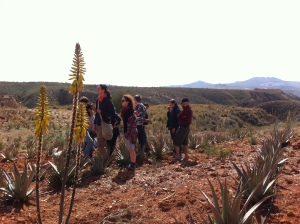 First of all we took a walk around the plantation whilst they recounted to us the many steps that they had taken to secure the financial backing to begin their project- they described to us how it was not easy at all to unearth the funding, but with a lot of motivation and after many battles with governmental organizations, banks etc. they managed to gather just enough money to begin the project.
First of all we took a walk around the plantation whilst they recounted to us the many steps that they had taken to secure the financial backing to begin their project- they described to us how it was not easy at all to unearth the funding, but with a lot of motivation and after many battles with governmental organizations, banks etc. they managed to gather just enough money to begin the project.
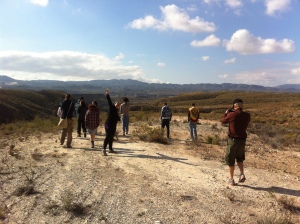 They led us around the landscape where we came across stunning canyons and fields chock-full of natural plants and herbs such as broom, thyme and esparto straw.
We also came across the faces of many animals that inhabit the land- wild goats, rabbits, foxes, the Mora turtle which is in danger of extinction, etc.
They led us around the landscape where we came across stunning canyons and fields chock-full of natural plants and herbs such as broom, thyme and esparto straw.
We also came across the faces of many animals that inhabit the land- wild goats, rabbits, foxes, the Mora turtle which is in danger of extinction, etc.
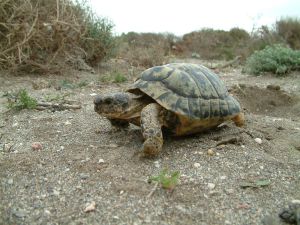 The couple told us of their plans to one day move and live on their finca (ranch/plantation)- with the intention of experimenting with their own elevated vegetable patches, abode construction, drylands, retaining walls made with tyres, solar systems to extract water and dry stone foundations, on which they want to place a small house made from adobe and pallets.
The couple told us of their plans to one day move and live on their finca (ranch/plantation)- with the intention of experimenting with their own elevated vegetable patches, abode construction, drylands, retaining walls made with tyres, solar systems to extract water and dry stone foundations, on which they want to place a small house made from adobe and pallets.
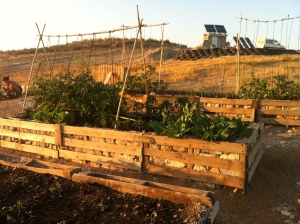 We then got stuck into their Aloe Vera project- we traced the lines and lines of Aloe Vera plants and were told about the different types of soil that they have on the plantation. They bought the Aloe plants, ecologically certified, in September 2012, at around 3-4 years of age- at this age the plants already contain all the necessary properties for their commercialization.
We then got stuck into their Aloe Vera project- we traced the lines and lines of Aloe Vera plants and were told about the different types of soil that they have on the plantation. They bought the Aloe plants, ecologically certified, in September 2012, at around 3-4 years of age- at this age the plants already contain all the necessary properties for their commercialization.
 On the plantation there is a drip irrigation which makes optimal use of the water that is extracted from the well- each plant needs around 0.8-1 litres of water per day. In winter however they stop using the irrigation system. The plantation method that is used at ‘Aloe of Sorbas’ is constructed of two separated lines of plants, with a distance of one meter between each plant and 3 meters between the lines. Both the irrigation system, the use of wild herbs, the use of fertilizer that comes from the neighbors goat and the deep respect shown for the specific geography of the region all make this project unique- demonstrating high levels of conscientiousness for our environment.
On the plantation there is a drip irrigation which makes optimal use of the water that is extracted from the well- each plant needs around 0.8-1 litres of water per day. In winter however they stop using the irrigation system. The plantation method that is used at ‘Aloe of Sorbas’ is constructed of two separated lines of plants, with a distance of one meter between each plant and 3 meters between the lines. Both the irrigation system, the use of wild herbs, the use of fertilizer that comes from the neighbors goat and the deep respect shown for the specific geography of the region all make this project unique- demonstrating high levels of conscientiousness for our environment.
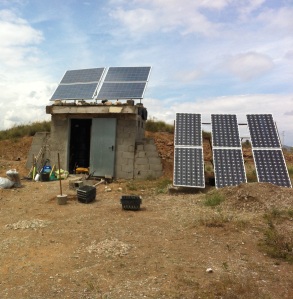 The management of the ‘bad herbs’ is also an important point for us. In ‘Aloe of Sorbas’ it is thought that respecting the natural foliage that grows on the plantation is a good way to improve the composition of the earth and the life of the plant. Each year Andres and Bea do an intervention to cut the wild herbs that grow between the plants- it is done with a weeding machine that spreads the cuttings on the ground to decompose and provide nutrients and shade for the earth. The cutting of the weeds is done in summer with the intention that they have finished their phase of flowering, both helping the bees and other insects, and also providing food for the local goats that eat the green herbs before summer starts.
The management of the ‘bad herbs’ is also an important point for us. In ‘Aloe of Sorbas’ it is thought that respecting the natural foliage that grows on the plantation is a good way to improve the composition of the earth and the life of the plant. Each year Andres and Bea do an intervention to cut the wild herbs that grow between the plants- it is done with a weeding machine that spreads the cuttings on the ground to decompose and provide nutrients and shade for the earth. The cutting of the weeds is done in summer with the intention that they have finished their phase of flowering, both helping the bees and other insects, and also providing food for the local goats that eat the green herbs before summer starts.
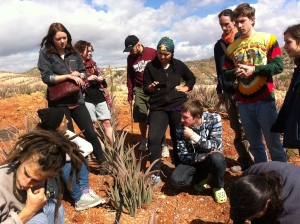 During this visit we even learned how to cut open the leaves and extract the shoots which we then replanted in a zone called “the nursery”, so as to continue the process of regenerating their plantation without the need to buy new plants.
During this visit we even learned how to cut open the leaves and extract the shoots which we then replanted in a zone called “the nursery”, so as to continue the process of regenerating their plantation without the need to buy new plants.
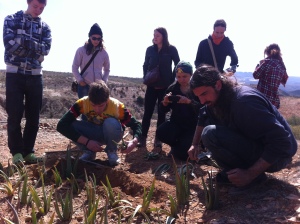 We would like to give thanks to ‘Aloe of Sorbas’ for giving us the opportunity to learn more about their amazing project- it was very interesting and enriching in every way. It allowed us to learn more about the basic benefits of Aloe Vera, so much so that here at Sunseed we will be hosting a workshop on how to extract the gel from the plants! Many thanks Andres and Bea for sharing your knowledge, we are greatly looking forward to the workshop!El Viernes 7 de Marzo hicimos una visita a nuestros vecinos que llevan el proyecto llamado “Aloe de Sorbas”, en la visita nos explicaron como y porque empezaron su plantación de Aloe Vera.
We would like to give thanks to ‘Aloe of Sorbas’ for giving us the opportunity to learn more about their amazing project- it was very interesting and enriching in every way. It allowed us to learn more about the basic benefits of Aloe Vera, so much so that here at Sunseed we will be hosting a workshop on how to extract the gel from the plants! Many thanks Andres and Bea for sharing your knowledge, we are greatly looking forward to the workshop!El Viernes 7 de Marzo hicimos una visita a nuestros vecinos que llevan el proyecto llamado “Aloe de Sorbas”, en la visita nos explicaron como y porque empezaron su plantación de Aloe Vera.
 La visita empezó dando una vuelta por los terrenos donde nos explicaron todos los pasos que tuvieron que seguir para conseguir la financiación para empezar el proyecto, no fue nada fácil conseguir el dinero para arrancar con él, pero con mucho tesón y voluntad y después de pelearse con todos los órganismos gubernamentales, bancos, etc, conseguieron el poco dinero que necesitaban para empezar el proyecto.
La visita empezó dando una vuelta por los terrenos donde nos explicaron todos los pasos que tuvieron que seguir para conseguir la financiación para empezar el proyecto, no fue nada fácil conseguir el dinero para arrancar con él, pero con mucho tesón y voluntad y después de pelearse con todos los órganismos gubernamentales, bancos, etc, conseguieron el poco dinero que necesitaban para empezar el proyecto.
 Nos enseñaron el entorno donde nos encontramos rodeados de impresionantes barrancos, plagados de plantas endémicas como son las retamas, espartos, tomillo, etc.
Nos enseñaron el entorno donde nos encontramos rodeados de impresionantes barrancos, plagados de plantas endémicas como son las retamas, espartos, tomillo, etc.
 Pudimos encontrar rastros de los animales que habitan los terrenos, cabras salvajes, conejos, zorros, jinetas, tortuga Mora, etc…
Pudimos encontrar rastros de los animales que habitan los terrenos, cabras salvajes, conejos, zorros, jinetas, tortuga Mora, etc…
 Tortuga Mora, en peligro de extinción.
También nos enseñaron su proyecto para mudarse a vivir a la finca, con su huerto con bancales elevados, construcciones con adobe, water seco en construcción, muro de contención con neumáticos, el sistema solar para extracción de agua y los cimientos de piedra seca donde ubicaran una caseta construida con palets y adobe.
Tortuga Mora, en peligro de extinción.
También nos enseñaron su proyecto para mudarse a vivir a la finca, con su huerto con bancales elevados, construcciones con adobe, water seco en construcción, muro de contención con neumáticos, el sistema solar para extracción de agua y los cimientos de piedra seca donde ubicaran una caseta construida con palets y adobe.
 Bancales elevados Aloe de Sorbas
Después de todo esto se metieron de lleno en la plantación de Aloe Vera, recorrieron las calles donde están plantadas y nos enseñaron el comportamiento del Aloe Vera con los distintos tipos de suelo que tienen dentro de la plantación. En la plantación de Aloe de Sorbas compraron las plantas en septiembre de 2012 con certificado ecológico y con 3-4 años de edad para empezar a producir lo antes posible, con esta edad las plantas de Aloe Vera ya contienen todas las propiedades necesarias para su comercialización.
Bancales elevados Aloe de Sorbas
Después de todo esto se metieron de lleno en la plantación de Aloe Vera, recorrieron las calles donde están plantadas y nos enseñaron el comportamiento del Aloe Vera con los distintos tipos de suelo que tienen dentro de la plantación. En la plantación de Aloe de Sorbas compraron las plantas en septiembre de 2012 con certificado ecológico y con 3-4 años de edad para empezar a producir lo antes posible, con esta edad las plantas de Aloe Vera ya contienen todas las propiedades necesarias para su comercialización.
 En su plantación disponen de riego a goteo para optimizar el agua que extraen de un pozo con un sistema solar, las cantidades de agua que recibe cada planta ronda los 0,8Litros/día con un máximo de 1Litro/día por planta, parando el riego en los meses de invierno.
En su plantación disponen de riego a goteo para optimizar el agua que extraen de un pozo con un sistema solar, las cantidades de agua que recibe cada planta ronda los 0,8Litros/día con un máximo de 1Litro/día por planta, parando el riego en los meses de invierno.
 El marco de plantación que usan en Aloe de Sorbas se estructura en bloques de dos filas separadas entre sí 1 metro y cada bloque de filas separadas 3 metros. Las plantas están enfiladas a una distancia de 1 metro entre sí. El sistema de riego, la utilización de las hierbas silvestres, la utilización del abono de las ganaderos vecinos que les facilitan el abono de cabra y el respeto por la geografía de la plantación hacen su proyecto único, respetando al máximo nuestro entorno.
El marco de plantación que usan en Aloe de Sorbas se estructura en bloques de dos filas separadas entre sí 1 metro y cada bloque de filas separadas 3 metros. Las plantas están enfiladas a una distancia de 1 metro entre sí. El sistema de riego, la utilización de las hierbas silvestres, la utilización del abono de las ganaderos vecinos que les facilitan el abono de cabra y el respeto por la geografía de la plantación hacen su proyecto único, respetando al máximo nuestro entorno.
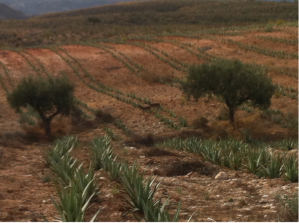 El manejo de las ¨malas hierbas¨ es un punto importante para ellos. En Aloe de Sorbas piensan que es importante respetar las hierbas que crecen dentro de la plantación para mejorar la estructura del suelo y su vida. Se realiza una intervención al año para cortar las hierbas silvestres que crecen entre las plantas, se realiza con una maquina desbrozadora dejando los restos del corte sobre el suelo para que se descompongan y aporten nutrientes y sombra al suelo. El corte de las hierbas silvestres se realiza en verano intentando así que todas las hierbas hayan acabado su fase de floración, ayudando a las abejas y otros insectos, también se acercan las cabras salvajes hasta la plantación para alimentarse de estas hierbas mientras están verdes antes del verano.
El manejo de las ¨malas hierbas¨ es un punto importante para ellos. En Aloe de Sorbas piensan que es importante respetar las hierbas que crecen dentro de la plantación para mejorar la estructura del suelo y su vida. Se realiza una intervención al año para cortar las hierbas silvestres que crecen entre las plantas, se realiza con una maquina desbrozadora dejando los restos del corte sobre el suelo para que se descompongan y aporten nutrientes y sombra al suelo. El corte de las hierbas silvestres se realiza en verano intentando así que todas las hierbas hayan acabado su fase de floración, ayudando a las abejas y otros insectos, también se acercan las cabras salvajes hasta la plantación para alimentarse de estas hierbas mientras están verdes antes del verano.
 En la visita que hicimos tambien realizamos trabajos de corte de hojas y extracción de hijuelos que luego plantamos en una zona que llamamos ¨La guardería¨ donde fuimos poniendo los hijuelos de Aloe para ir regenerando su plantación sin necesidad de comprar nuevas plantas.
En la visita que hicimos tambien realizamos trabajos de corte de hojas y extracción de hijuelos que luego plantamos en una zona que llamamos ¨La guardería¨ donde fuimos poniendo los hijuelos de Aloe para ir regenerando su plantación sin necesidad de comprar nuevas plantas.
 Queremos agradecer a Aloe de Sorbas por dejarnos conocer mas de cerca su precioso proyecto, fue muy interesante, fue una experiencia enriquecedora en todos los sentidos, pudimos conocer mas a fondo los beneficios del Aloe Vera, tanto es así que volveran a realizar un taller de extracción de gel de Aloe Vera en Los Molinos del Río Aguas dentro del proyecto Sunseed desert technology.
Muchas gracias Andres y Bea por compartir toda vuestra sabiduria, os esperamos para realizar pronto el taller de extracción de gel !!!
Queremos agradecer a Aloe de Sorbas por dejarnos conocer mas de cerca su precioso proyecto, fue muy interesante, fue una experiencia enriquecedora en todos los sentidos, pudimos conocer mas a fondo los beneficios del Aloe Vera, tanto es así que volveran a realizar un taller de extracción de gel de Aloe Vera en Los Molinos del Río Aguas dentro del proyecto Sunseed desert technology.
Muchas gracias Andres y Bea por compartir toda vuestra sabiduria, os esperamos para realizar pronto el taller de extracción de gel !!!
